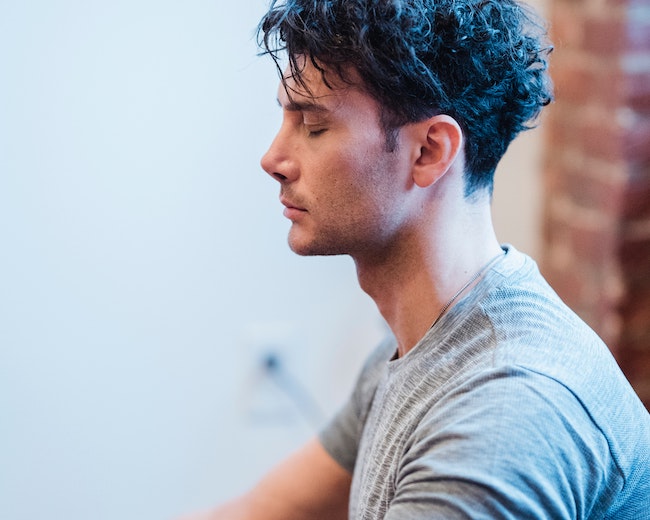Ahimsa is a cornerstone of asana practice, and no doubt as a yoga teacher you aim to support your students to have an injury- and pain-free practice. But is it possible that some of the very words you use to protect your students from injury, are actually contributing to their experience of pain?
Understanding the fundamentals of pain science and the power of words will enable you to guide your yoga students away from fear and pain, and towards empowerment, ease, and wellness. By using mindful and supportive language, you can guide your students through challenges while minimising the perception of pain.
 Pain Science
Pain Science
To understand how language impacts the experience of pain, it’s helpful to have a basic understanding of pain science.
Pain is a multi-faceted response involving the brain and the nervous system. Sensory receptors called nociceptors respond to potentially harmful stimuli, such as intense pressure, extreme temperatures, or tissue damage. Nociceptors send a signal to the brain, alerting it to potential danger. The brain processes this message by comparing the sensation to previous experiences and taking into account emotions, beliefs and the surrounding environment. All of these factors contribute to whether we experience pain, and the extent and duration of that pain.
In short, pain is not necessarily a reflection of tissue damage. Rather, it’s the brain’s perception of how much danger we’re in.
The Power of Words
Now let’s consider the power of words in a yoga class. As yoga teachers, we guide students in exploring their bodies, minds, and emotions. However, the language we use can lead to our brains feeling that we’re safe, or feeling that we’re in danger – which will have an impact on whether our students experience pain.
Nocebic Language: The Dark Side
No doubt you’ve heard of the placebo effect – an improvement or positive effect due to an individual’s belief in a treatment, not the treatment itself. ’Nocebo’ is the opposite of ‘placebo’: while the placebo effect harnesses the power of positive beliefs and expectations, the nocebo effect is the detrimental impact of negative beliefs and expectations. Nocebic language refers to the use of negative, fear-inducing, or pain-associated words or phrases. These words can trigger or amplify the perception of pain, even in the absence of actual harm.
For instance, saying something (well-intentioned) like:
“Be careful, this posture puts your neck in a vulnerable position. If you feel any pain, release straight away…”
… can lead to students feeling that their bodies are fragile and at risk of damage. As a result, the brain is more likely to provide an output of pain – even though no physical damage is being caused.
So how can we provide students with key information, without leading them towards feeling unsafe?
Positive and Empowering Language
Instead of using nocebic language, aim for language that creates a sense of safety. Here’s how we can do that:
- Frame sensations positively
Rather than saying, “This might hurt if you’re not used to it,” consider something like, “You might notice sensations that are new or challenging.” - Use neutral language
Acknowledge that yoga can be intense without instilling fear. Replace cues such as “If you feel pain in your knee, back off” with something more innocuous like “If your knee feels sensitive or touchy, ease back”. Instead of “If it hurts your neck you can look down” try something like “You can look down, forward or up – see what feels best for your neck.” - Replace phrases that indicate the body is fragile
For example, replace phrasing such as “Press your fingers down to protect your wrists” (‘protect’ implying that we’re fragile and prone to damage) with something like “Press your fingers down to create a strong foundation”.
Rather than “Engage your core to protect your lower back” try something like “Draw your lower belly in to create a sense of stability”.
Instead of “Avoid turning your head; this is unsafe for your neck” consider something like, “Keep your head centred to keep your neck comfortable.” - Encourage self-awareness
Teach students to explore their sensations with curiosity and non-judgment. Use phrases like, “Take a moment to notice what’s happening in your body” rather than implying discomfort is a given. - Acknowledge individual differences
Recognise that every body is unique. What’s challenging for one student might be comfortable for another. Encourage students to honour their own limits and respect their bodies, and provide options to suit all students.
Yoga is a practice of self-discovery and transformation and as yoga teachers, our role is to facilitate this journey by creating a safe, supportive environment. Our language has the potential to either support or hinder our students’ practice and wellbeing. By respecting the mind-body connection and embracing affirming language, we can guide our students towards growth while minimising the perception of pain.
If you’re interested in fine-tuning your communication as a yoga teacher, you might also be interested in this post on language to create a safe space, and this one on invitational language.
If you’d like to learn more about pain science, this short course by Yoga Medicine is well worthwhile.
Note: This article provides a general overview of pain science and the importance of language in yoga teaching. It is not intended as a replacement for professional training or medical advice.
References:
Barsky, A. J., Saintfort, R., Rogers, M. P., & Borus, J. F. (2002). Nonspecific medication side effects and the nocebo phenomenon. JAMA, 287(5), 622-627.
Moseley, G. L., & Butler, D. S. (2015). Fifteen years of explaining pain: The past, present, and future. The Journal of Pain, 16(9), 807-813.
Moseley, G. L. (2015). Reconceptualising pain according to modern pain science. Physical Therapy Reviews, 19(5), 262-265.






Thanks Marita, Appreciating these examples and context.
Thanks Nat! I’m glad you found it helpful. xo